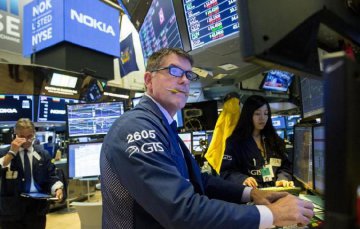NEW YORK, July 13 (Xinhua) -- U.S. stocks wrapped up the week on a strong note, as Wall Street has been boosted by the two-day testimony of U.S. Federal Reserve chairman to the Congress, which opened the door wider for potential rate cuts later this month.
In the week ending July 12, the Dow rose 1.53 percent, the S&P 500 was up 0.78 percent, and the Nasdaq gained 1.02 percent.
This week marked cheerful trading sessions for the market with a low start yet an upbeat ending, and the three major indexes hit record highs during the week.
On Friday, the three major indexes ended with marked gains, capping off a robust week as investors' bets on future rate cuts by the Fed continued to underpin the market.
The Dow Jones Industrial Average rose 243.95 points, or 0.90 percent, to 27,332.03. The S&P 500 was up 13.86 points, or 0.46 percent, to 3,013.77. The Nasdaq Composite Index rose 48.10 points, or 0.59 percent, to 8,244.14.
Throughout the week, market participants closely observed and studied the two-day monetary policy testimony of Jerome Powell and the latest meeting minutes of the Fed, which struck a similarly dovish tone.
At the U.S. House Committee on Financial Services, Powell said Wednesday that the central bank was prepared to "act as appropriate" to prop up economic expansion and support inflation amid a raft of risks and uncertainties, including weak inflation, slower global growth, and a pullback in business investment due to lingering U.S.-China trade frictions.
"Since our May meeting, however, these crosscurrents have reemerged, creating greater uncertainty," he said. "Many FOMC (Federal Open Market Committee) participants saw that the case for a somewhat more accommodative monetary policy had strengthened."
"Since then, based on incoming data and other developments, it appears that uncertainties around trade tensions and concerns about the strength of the global economy continue to weigh on the U.S. economic outlook. Inflation pressures remain muted," Powell noted.
"The big takeaways are the Fed continues to be dovish... They're going to continue to be accommodative, and they're gonna take action when necessary," Mark Otto, a senior trader at U.S. electronic market maker GTS, told Xinhua on Thursday.
"The other takeaway is that global growth has become more of a concern. It's coming to the forefront as they're saying that global indicators are something that they're watching," he noted.
"In other words, the Fed is taking out insurance with hopes of extending the recovery and ultimately gaining policy space," said a Bank of American (BofA) Merrill Lynch Global Research report on Wednesday, adding that the market has acted "as if the Fed has already cut."
In this aspect, Otto said current investor sentiment remained "to the upside." "There's a lot of positivity out there. I think that any pullback has been an opportunity for traders to lock in their profits and then reestablish new positions."
From his perspective, Peter Tuchman, a seasoned trader at Quattro Securities, also anticipated the Fed to lower its benchmark interest rate's target range "sooner than later" by either 25 basis points or 50.
"It seems like it's a done deal...I think if they do not cut it, the market will be deeply disappointed," Tuchman told Xinhua on Wednesday.
June's surprisingly robust jobs report released on July 5 tempered expectations on more aggressive rate cuts and dampened stocks' gains at the beginning of the week.
However, Powell's remarks and the Fed's minutes added to market bets on greater cutting range. Probabilities for a cut by 50 basis points picked up to 22.5 percent, while the remaining 77.5 percent fell on a 25 basis-point cut, according to CME Group's FedWatch tool on Friday.
Federal Reserve officials also expressed willingness to embrace a near-term rate cut, which "could help cushion the effects of possible future adverse shocks to the economy," according to the FOMC's minutes of its meeting on June 18-19, which was released on Wednesday afternoon.
"Participants generally agreed that downside risks to the outlook for economic activity had risen materially since their May meeting, particularly those associated with ongoing trade negotiations and slowing economic growth abroad," said the minutes.
"We now expect a 25bp (basis point) cut at the July 31st meeting followed by two more cuts at the next two meetings," said the BofA Merrill Lynch's report, adding that Powell's testimony has hinted "strongly at an upcoming cut."
Meanwhile, Wall Street digested a slew of key economic data this week, which indicated decent inflation levels and the sustained strength of the labor market.
On the economic front, U.S. producer price index slightly rose 0.1 percent in June, the same increase as in May, said the Bureau of Labor Statistics on Friday.
The index rose 1.7 percent for the 12 months ended in June, the lowest rate of increase since it advanced 1.7 percent in January 2017, as dragged down by the 3.1-percent drop in the index for energy for the month.
U.S. jobless claims fell last week to the lowest level over the last three months, signaling a strong labor market.
In the week ending July 6, the number of people who applied for unemployment benefits registered at 209,000, a decrease of 13,000 from the previous week's revised level, said the Labor Department on Thursday.
U.S. Consumer Price Index (CPI), a key metric of price levels of consumer goods and services, increased 0.1 percent in June, the same increase as in May, said the U.S. Bureau of Labor Statistics on Thursday.
U.S. job openings slightly declined to a seasonally adjusted 7.32 million on the last business day of May month over month, said the Labor Department on Tuesday.
The job openings rate was 4.6 percent, down from the 4.7 percent in April. Job openings decreased in a number of industries with the largest decreases in construction, transportation, warehousing, and utilities, as well as real estate and rental and leasing.



















Latest comments